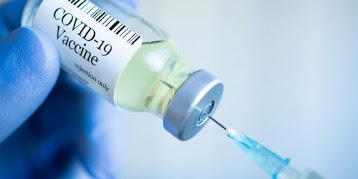"The Grandest Human Experiment In History"
by Raúl Ilargi Meijer
"Let’s not beat around the bush any longer, but call things for what they are: we are in the middle of the grandest medical and genetic experiment in the history of mankind, by a mile and a half. The experiment is already so advanced that we can only wait and see its consequences. We don’t know what these will be, and that is exactly the problem with it: we normally run elaborate tests in advance of such experiments to minimize their potential negative effects and their adverse outcomes for our species. This time around, we did not.
There are well-established procedures to test novel substances before they are used in human experiments, which take years – for good reason. We have decided to almost entirely neglect these procedures in the case of Covid “vaccines”, in the same way that we have neglected to look for alternative ways to defend ourselves from the virus. And these two things are closely connected: in case ivermectin or Budesonide or even just vitamin D had shown efficacy in Covid trials, the vaccines could not have received emergency authorization.
Moreover, you will now be punished – in access to travel, work, other activities- for NOT having received a dose of never approved chemicals. The world is upside down, but after months upon months of lockdowns, people think upside down is just how they like it. Anything is better than being locked up/down. Stockholm syndrome writ large.
And now, as we survey the landscape, we see that the proponents of the experiments are already dreaming of much bigger adventures - and profits. The emergency authorization was all they needed, a full approval was not necessary. Some people behind the companies behind mRNA techniques, such as Moderna and Pfizer, may tell themselves that they are doing mankind a big favor, but they would be the first to know that the well-established procedures are there for good reasons. But yeah, they threaten their short-term profits, we get that.
In 1947, a world disgusted by Joseph Mengele’s medical experiments on German prisoners said: never again. Yes, sounds familiar. The Nuremberg Code was drafted: The ten points of the code were given in the section of the judges’ verdict entitled “Permissible Medical Experiments”:
1. The voluntary consent of the human subject is absolutely essential.
2. The experiment should be such as to yield fruitful results for the good of society, unprocurable by other methods or means of study, and not random and unnecessary in nature.
3. The experiment should be so designed and based on the results of animal experimentation and a knowledge of the natural history of the disease or other problem under study that the anticipated results will justify the performance of the experiment.
4. The experiment should be so conducted as to avoid all unnecessary physical and mental suffering and injury.
5. No experiment should be conducted where there is an a priori reason to believe that death or disabling injury will occur; except, perhaps, in those experiments where the experimental physicians also serve as subjects.
6. The degree of risk to be taken should never exceed that determined by the humanitarian importance of the problem to be solved by the experiment.
7. Proper preparations should be made and adequate facilities provided to protect the experimental subject against even remote possibilities of injury, disability, or death.
8. The experiment should be conducted only by scientifically qualified persons. The highest degree of skill and care should be required through all stages of the experiment of those who conduct or engage in the experiment.
9. During the course of the experiment the human subject should be at liberty to bring the experiment to an end if he has reached the physical or mental state where continuation of the experiment seems to him to be impossible.
10. During the course of the experiment the scientist in charge must be prepared to terminate the experiment at any stage, if he has probable cause to believe, in the exercise of the good faith, superior skill and careful judgment required of him that a continuation of the experiment is likely to result in injury, disability, or death to the experimental subject.
I’ll leave it up to you to decide to which extent the mRNA - and other unapproved vaccines - experiment abides by that code. Which in 1964 was further extended and formalized in the Helsinki Declaration. Meanwhile, there are tons of stories like these: There are so many tragic stories now of loved ones dying after taking an experimental COVID injection, that one has to wonder if people are now starting to become desensitized by all these stories as the public is perhaps being conditioned to accept “death by lethal injection” as part of the “new normal?” A 50-year-old woman in Canada, a 61-year-old woman in Orange, California, and a 58-year-old man in Minnesota are three more casualties following COVID-19 injections.
[..] Lisa Basiuk-Stonehouse passed away May 3, 2021 after her AstraZeneca vaccine. According to her Aunt Shari, blood clots caused a stroke and the matter is still being investigated. Lisa’s husband Morrie passed away two years ago, according to the Facebook post by Lisa’s Aunt Shari Turner. Lisa and Morrie’s daughter Jordan, is now 19 years old. A gofundme account has been created, and as of May 3, 2021 the fundraiser had generated 19k of the 25k goal. It appears Lisa and her family are very loved.
[..] HIBBING, MINNESOTA — A 57-year-old trucker and avid fisherman is dead in one of the more heartbreaking stories we’ve covered on this blog. Mr. John Medved received the experimental Johnson & Johnson viral vector shot on April 1, according to his daughter, Mrs. Rachel Weise. Twelve days later, Mr. Medved was in the emergency room due to extreme shortness of breath. Doctors diagnosed him with a pulmonary embolism, aka blood clots in his lungs. He was placed on a ventilator and in a medically-induced coma the next day as his condition rapidly deteriorated. Doctors then discovered that Mr. Medved had a stroke that damaged the entire left side of his brain. The doctor told Rachel that it was the worst stroke he’d seen in his career.
[..] The Orange County Coroner’s office is investigating the death of a woman who died just days after she received her second dose of the Moderna vaccine. The family says the grandmother was healthy before she got her shot, and that her sudden death came as a shock. A conversation with staff at the Orange County Coroner’s office about Griselda Flores’ death, raised red flags for her son Richard Cardenas and the family. “They made it seem like this was not the first call that they had,” Cardenas said. Assistant Chief Deputy Coroner Brad Olsen says that’s right. Olsen told Eyewitness News a handful of deaths, including Flores’, are under investigation because they happened one to three days after the person got a COVID-19 vaccine dose.
But yeah, the fact that those well-established procedures were ignored completely for the Covid vaccines, leads scientists and drug makers to believe they have a lot more leeway now for the next series of experiments. Some of which are truly unsettling, to me at least. Experimenting on human embryo cells which were never meant to come to full growth is right up there with Mengele in my mind:
"CRISPR Madness: Welcome to the Age of Genetic Chaos": Body cell, or “somatic,” modification is in line with traditional medical practice, where a sick person undergoes a procedure or takes a drug that may be the best means for saving their life or sparing them a life of misery. It might or might not be successful but is a risk a patient or those responsible for them can reasonably assume. In embryo modification, in contrast, the tissues of the body are pervasively altered as it is taking form in ways that are poorly understood.
Even so-called single-gene traits are established with the participation of dozens or hundreds of other genes often acting in compensatory fashions, leading to the situation that in some individuals a double dose of the most threatening cystic fibrosis or sickle cell gene variants leads to no adverse symptoms at all. Under such circumstances, a single gene change, no matter how accurately administered, is an uncontrolled experiment on a prospective person that may do more harm than good. While errors can be propagated to future generations (leading to the misleading claim that the hazard is primarily through the reproductive cells or “germ line”), damage would also be incurred by the initial experimentally produced person.
All the books under review, from the frankly promotional ones of Isaacson, Kevin Davies and Jamie Metzl, to the more balanced one of Françoise Baylis, accept the baseless premise propounded by many
CRISPR researchers that gene modification of embryos can be done safely, as does the reviewer herself. “[I]n ten years or so, we will probably meet the minimum conditions of safety and predictability for editing out single-gene diseases,” de Souza writes, and there is no indication that any of the authors disagrees.
Baylis, the book author most critical of the technology, is similarly concerned with ensuring that the fruits of this powerful, perfectable technology will be distributed equitably, and that enough disparate voices participate in deciding whether the endeavor (i.e., making experimental changes in prospective children; irreversibly changing the human gene pool; bringing human production into the commodity system) is what “we” really want.
And wouldn’t you know, as Whitney Webb describes, there a major convergence in this field, with the US government involved, and the Pentagon, Silicon Valley, Big Tech and Big Pharma (and of course the media). All for the benefit of mankind, wouldn’t you know. The mRNA technology, for which Moderna could never get any approval prior to the Covid era, now looks set to be used in many other fields. Cancer and terrorism and preventing crime and reading minds, it’s all here:
"This Biden Proposal Could Make the US a “Digital Dictatorship”:
"Last Wednesday, President Biden was widely praised in mainstream and health-care–focused media for his call to create a “new biomedical research agency” modeled after the US military’s “high-risk, high-reward” Defense Advanced Research Projects Agency, or DARPA. As touted by the president, the agency would seek to develop “innovative” and “breakthrough” treatments for cancer, Alzheimer’s disease, and diabetes, with a call to “end cancer as we know it.” Far from “ending cancer” in the way most Americans might envision it, the proposed agency would merge “national security” with “health security” in such as way as to use both physical and mental health “warning signs” to prevent outbreaks of disease or violence before they occur.
[..] ARPA-H will likely heavily fund and promote mRNA vaccines as one of the “breakthroughs” that will cure cancer. Some of the mRNA vaccine manufacturers that have produced some of the most widely used COVID-19 vaccines, such as the Pfizer/BioNTech vaccine, stated just last month that “cancer is the next problem to tackle with mRNA tech” post-COVID. BioNTech has been developing mRNA gene therapies for cancer for years and is collaborating with the Bill & Melinda Gates Foundation to create mRNA-based treatments for tuberculosis and HIV.
[..] the flagship program of HARPA would be SAFE HOME, short for Stopping Aberrant Fatal Events by Helping Overcome Mental Extremes. SAFE HOME would suck up masses of private data from “Apple Watches, Fitbits, Amazon Echo, and Google Home” and other consumer electronic devices, as well as information from health-care providers to determine if an individual might be likely to commit a crime. The data would be analyzed by artificial intelligence (AI) algorithms “for early diagnosis of neuropsychiatric violence.”
The Department of Justice’s pre-crime approach known as DEEP was activated just months before Trump left office; it was also justified as a way to “stop mass shootings before they happen.” Soon after Biden’s inauguration, the new administration began using information from social media to make pre-crime arrests as part of its approach toward combatting “domestic terror.” Given the history of Silicon Valley companies collaborating with the government on matters of warrantless surveillance, it appears that aspects of SAFE HOME may already be covertly active under Biden, only waiting for the formalization of ARPA-H/HARPA to be legitimized as public policy.
[..] While nominally focused on “bioterrorist attacks,” TIA’s Bio-Surveillance project also sought to acquire early detection capabilities for “normal” disease outbreaks. Bio-Surveillance and related DARPA projects at the time, such as LifeLog, sought to harvest data through the mass use of some sort of wearable or handheld technology. These DARPA programs were ultimately shut down due to the controversy over claims they would be used to profile domestic dissidents and eliminate privacy for all Americans in the US.
[..] This most recent effort to create ARPA-H/HARPA combines well with the coordinated push of Silicon Valley companies into the field of health care, specifically Silicon Valley companies that double as contractors to US intelligence and/or the military (e.g., Microsoft, Google, and Amazon). During the COVID-19 crisis, this trend toward Silicon Valley dominance of the health-care sector has accelerated considerably due to a top-down push toward digitalization with telemedicine, remote monitoring, and the like.
One interesting example is Amazon, which launched a wearable last year that purports to not only use biometrics to monitor people’s physical health and fitness but to track their emotional state as well. The previous year, Amazon acquired the online pharmacy PillPack, and it is not hard to imagine a scenario in which data from Amazon’s Halo wellness band is used to offer treatment recommendations that are then supplied by Amazon-owned PillPack.
[..] The military is currently being used to pilot COVID-19–related biometric wearables for “returning to work safely.” Last December, it was announced that Hill Air Force Base in Utah would make biometric wearables a mandatory part of the uniform for some squadrons. [..] While of interest to the military, these wearables are primarily intended for mass use—a big step toward the infrastructure needed for the resurrection of a bio-surveillance program to be run by the national-security state."
We continue to forget the lessons of the past. We worship “science” now. Decades of diligence and actual science, which were carefully crafted by our parents and grandparents, have been swept under the carpet under the guise of emergency in matter of months, and “science” takes that to mean all limits are off. Yes, governments and armies etc. would love to experiment on you and I, and tell us it’s for our own best sake. If we just wear a ring or a watch or an app, we will all benefit from centralized medical systems checking our symptoms 1000 times a second and beaming it all into some database, what could be better for us?
And maybe this is indeed inevitable, but it also contradicts a lot of what we, until now, consider to be freedom and liberty, of our decisions about our own existence, without anyone else interfering. And then on top of that they will try to force you into getting another mRNA jab, and then another, until you have very obviously no longer the genetic make-up that you were born with.
We are born into this world as healthy people, and we use our healthcare systems to correct in the still rare instances that we are not. But we will lose that presumption if and when we will be monitored 24/7 from the day we are born. Even while we are as healthy as our ancestors were when they were born. Do we benefit from this? Well, not as long as we remain healthy. Then it’s just more centralized crap.
You might say that we benefit when we get old or sick, sure, but then we must ask ourselves if we want some entity checking on us all the time while we’re just living a life like our parents did. You think that idea, of just living your life, independent from centralized powers, will disappear? I guess it’s possible, but it scares the heebees out of me.
And then you get back to asking what the logic is behind injecting perfectly healthy people, children even for g-d’s sake, with an untested chemical substance. Shouldn’t we leave healthy people alone? Oh, but they can’t prove they’re healthy… That’s the world upside down. And that’s what the mRNA manufacturers count on us to believe. That no-one is a normal healthy human being anymore until and unless they have been injected with an experimental substance. Governments, the Pentagon, Silicon Valley, Big Tech and Big Pharma want nothing more than for you to think that. Because then they got you for life. YOUR life."
○
Related:
○
"COVID Vaccines: Necessity, Efficacy and Safety"
by Doctors for Covid Ethics
"Abstract: COVID-19 vaccine manufacturers have been exempted from legal liability for vaccine-induced harm. It is therefore in the interests of all those authorizing, enforcing and administering COVID-19 vaccinations to understand the evidence regarding the risks and benefits of these vaccines, since liability for harm will fall on them. In short, the available evidence and science indicate that COVID-19 vaccines are unnecessary, ineffective and unsafe."
Please view this complete article here:

























